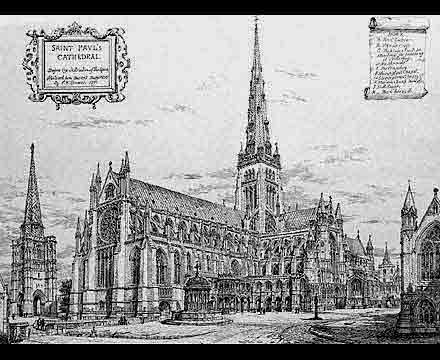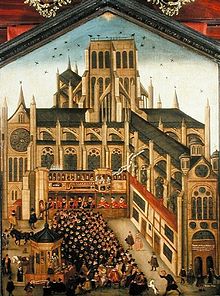
The Cathedral of St. Paul’s was the medieval church of the City of London, the fourth church to be built on the site on Ludgate Hill. The presence of the shrine of St. Erkenwald made the church a pilgrimage site in medieval times. The Anglo-Saxon Chronicle mentions a devastating fire in 1087 that destroyed much of London and the existing church at the time. William the Conqueror donated stone to build a new Romanesque-Norman cathedral. Construction started and would last until 1314. Two Anglo-Saxon Kings were buried there; Sebbi, King of the West Saxons and King Aethelred the Unready. There would be another devastating fire in 1135 that delayed construction. After this the architectural style of the cathedral changed into Early English Gothic. They erected a steeple in 1221.

The church was finally consecrated in 1240. After a series of storms caused considerable destruction to the building, in 1255 the Bishop of London asked for funds to repair the damaged roof and to extend the east end. These new works were completed in 1314 and at completion, the cathedral was one of the longest in the world, had one of the tallest spires and some of the finest stained glass. Monarchs and other noblemen often attended mass there and sometimes they conducted court business in the church. Several kings lay in state at Old St. Paul’s before their funerals in Westminster Abbey including Richard II, Henry VI and Henry VII. Beginning in the 14th Century, they used the nave as a kind of marketplace and meeting area and called it “Paul’s walk”. The wedding of Catherine of Aragon and Arthur Tudor, Prince of Wales and son of King Henry VII was held there in 1501. The building suffered damage during the Dissolution of the Monasteries under King Henry VIII.

In 1561, the spire caught fire and burned through the roof of the nave. The fire was so hot, it melted the bells and the lead covering the wooden spire poured down on the roof in a preview of what was to come 100 years later. They never replaced the spire. King James I, worried about the state of disrepair of the building, hired Inigo Jones, England’s first classical architect, to refurbish it. He commenced cleaning and repairs and added a classical style portico to the west front in 1630. The work stopped during the Civil War when the building suffered much mistreatment by Parliamentary forces. William Dugdale wrote a book “History of St. Paul’s Cathedral” in 1658, worried it might be torn down by The Protectorate under Oliver Cromwell.
After the Restoration of the monarchy, King Charles II hired Sir Christopher Wren, Surveyor of the King’s Works, to restore the cathedral. Immediately, Wren despaired of doing just repairs and wanted a new building erected. He imagined a magnificent dome. While the matter remained under discussion, money was found for repairs. They covered the old, decrepit building with wooden scaffolding and restoration commenced.
When the Great Fire of London broke out on Sunday, September 2, 1666, the printers, stationers and booksellers of Paternoster Row hastened to move their stock into the crypt of the cathedral, convinced it would be safe there. People in the surrounding area believed the thick walls of the building would keep whatever was inside safe and put their household goods inside. About eight o’clock in the evening on Tuesday, the flames had reached the roof. The demolition work had blocked lanes and alleys around the area making it difficult for firefighters to reach the cathedral. A little later the lead on the roof began to melt and flowed into the building. The stonework crashed and the lead ran down Ludgate Hill like a stream. When the flames reached the paper in the crypt, the whole building blew up into bright flames and lit up the sky.
A young student from Westminster School, William Taswell, walked to the cathedral on Wednesday after the fire was spent and found the ground so hot it nearly burned through his shoes. The entire building was in complete shambles except for the high altar at the east end which was nearly intact. Parts of the building were still burning, smoking or smoldering. The bells were melted. There was a hole where the crypt had been with the bookseller’s papers still afire. When the roof collapsed, it had broken effigies and monuments and cracked open tombs and coffins. Bones and corpses lay exposed and scattered. The corpse of Robert Braybrooke, a Bishop of London who had died in 1404 was uncovered and found to be perfectly complete and undamaged.

Immediately after the fire, they consulted Sir Christopher Wren about repairing the remains of the Cathedral. He called for fundraising to begin on a new building entirely. But they decided to repair what remained of the cathedral. In the spring of 1668, the repairs began. It soon stopped when part of the surviving nave collapsed, causing the workmen to run for their lives. Wren returned to the rubble for his opinion and again he urged for a new building to be built. By July of 1668, Wren was commissioned to design of a new building and demolition work began in August.
The demolition caused more deaths than the fire. Men were scrambling over the unsteady ruins, using pickaxes to chop at the stonework which was coated with lead. Some men fell to their deaths and limbs were broken. The workmen finally refused to climb up the 200 foot tall tower. They brought in a military engineer to mine one of the pillars supporting the tower. An eighteen pound charge of gunpowder was laid at the foot of the pillar and the fuse lit. The explosion was stunning. The surrounding neighborhood thought there was an earthquake. Due to their success, they decided to do another. One of Wren’s assistants set the charge but he used too much gunpowder, causing debris to fly everywhere. The neighbors of the cathedral asked an end to the explosions so they stopped and used a battering ram instead.
Eventually Sir Christopher Wren got what his wish and began designing the new cathedral with the dome he had always imagined. The new magnificently stunning St. Paul’s Cathedral was started in 1675 and declared officially complete by Parliament in 1710.
Further reading: “By Permission of Heaven: The True Story of the Great Fire of London” by Adrian Tinniswood

[…] fighting. Aethelred was to die on April 23, 1016 at the age of forty eight. He was buried in Old St. Pauls Cathedral in London. After internal strife between Edmund and the Danes, Cnut emerged as the leader and […]
LikeLike
[…] rights of English citizenship. That same year, her father died and a funeral service was held in Old St. Paul’s Cathedral in London. In April of 1434, she received the robes of the Order of the […]
LikeLike
[…] England in November 1501 and there was a magnificent celebration of the nuptials in Old St. Paul’s Cathedral. In December, Catherine and Arthur went to Ludlow so the prince could resume his duties. […]
LikeLike
[…] of English citizenship. That same year, her father died and a funeral service was held in Old St. Paul’s Cathedral in London. In April of 1434, she received the robes of the Order of the […]
LikeLiked by 1 person
Excellent account of the old cathedral and how they set about replacing it!
LikeLike
[…] was a magnificent wedding ceremony at Old St. Paul’s Cathedral in London. King Henry VII wanted to impress the people. The couple were sent to Ludlow to live and […]
LikeLike
[…] arrived in England in November 1501 and there was a magnificent celebration of the nuptials in Old St. Paul’s Cathedral. In December, Catherine and Arthur went to Ludlow so the prince could resume his duties. […]
LikeLike
[…] alms for the poor. Beginning on May 11, impressive funeral processions were staged from Richmond to St. Paul’s Cathedral and then on to Westminster Abbey where he was buried in his new chapel next to his wife. In 1518, […]
LikeLike
[…] Edward VI. She was part of the procession following Marie de Guise from the Bishop’s Palace at St. Paul’s Cathedral to Westminster where she was received by the Duke of Northumberland and she dined with King Edward. […]
LikeLike
[…] ended with Catherine being presented to the Archbishop of Canterbury who took her to the door of St. Paul’s Cathedral. A pageant was held in the churchyard and gifts were given to Catherine by the mayor and other […]
LikeLike
Seeing St. Paul’s Cathredal was one of the highlights of our trip to London. Very interesting story behind this great structure.
LikeLike
Truly is a magnificent structure! Great to know the history behind the current building.
LikeLike